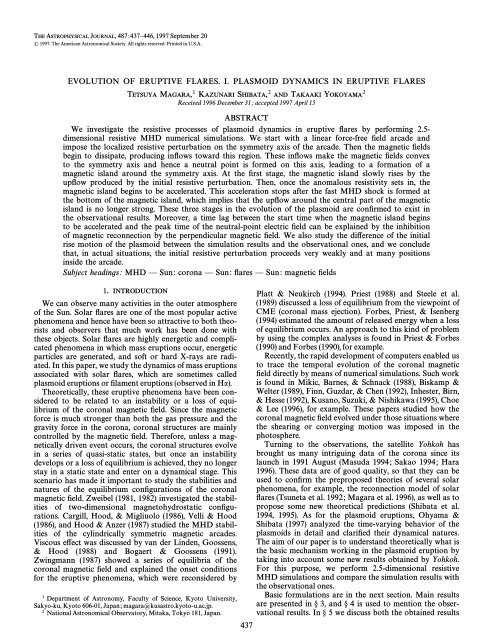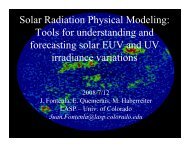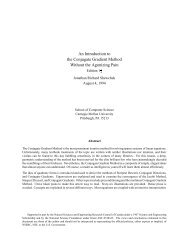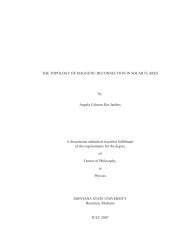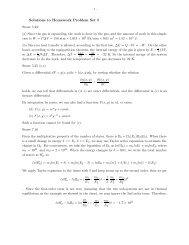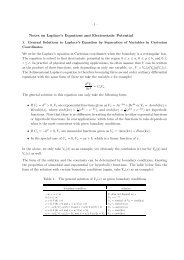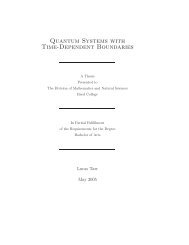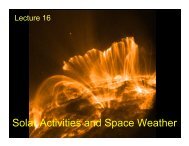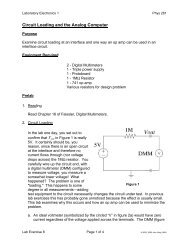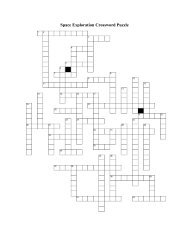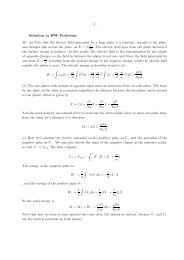Magara, T., Shibata, K., & Yokoyama, T. 1997, ApJ, 487, 437
Magara, T., Shibata, K., & Yokoyama, T. 1997, ApJ, 487, 437
Magara, T., Shibata, K., & Yokoyama, T. 1997, ApJ, 487, 437
Create successful ePaper yourself
Turn your PDF publications into a flip-book with our unique Google optimized e-Paper software.
THE ASTROPHYSICAL JOURNAL, <strong>487</strong>:<strong>437</strong>È446, <strong>1997</strong> September 20<br />
( <strong>1997</strong>. The American Astronomical Society. All rights reserved. Printed in U.S.A.<br />
EVOLUTION OF ERUPTIVE FLARES. I. PLASMOID DYNAMICS IN ERUPTIVE FLARES<br />
TETSUYA MAGARA,1 KAZUNARI SHIBATA,2 AND TAKAAKI YOKOYAMA2<br />
Received 1996 December 31; accepted <strong>1997</strong> April 15<br />
ABSTRACT<br />
We investigate the resistive processes of plasmoid dynamics in eruptive Ñares by performing 2.5-<br />
dimensional resistive MHD numerical simulations. We start with a linear force-free Ðeld arcade and<br />
impose the localized resistive perturbation on the symmetry axis of the arcade. Then the magnetic Ðelds<br />
begin to dissipate, producing inÑows toward this region. These inÑows make the magnetic Ðelds convex<br />
to the symmetry axis and hence a neutral point is formed on this axis, leading to a formation of a<br />
magnetic island around the symmetry axis. At the Ðrst stage, the magnetic island slowly rises by the<br />
upÑow produced by the initial resistive perturbation. Then, once the anomalous resistivity sets in, the<br />
magnetic island begins to be accelerated. This acceleration stops after the fast MHD shock is formed at<br />
the bottom of the magnetic island, which implies that the upÑow around the central part of the magnetic<br />
island is no longer strong. These three stages in the evolution of the plasmoid are conÐrmed to exist in<br />
the observational results. Moreover, a time lag between the start time when the magnetic island begins<br />
to be accelerated and the peak time of the neutral-point electric Ðeld can be explained by the inhibition<br />
of magnetic reconnection by the perpendicular magnetic Ðeld. We also study the di†erence of the initial<br />
rise motion of the plasmoid between the simulation results and the observational ones, and we conclude<br />
that, in actual situations, the initial resistive perturbation proceeds very weakly and at many positions<br />
inside the arcade.<br />
Subject headings: MHD È Sun: corona È Sun: Ñares È Sun: magnetic Ðelds<br />
1. INTRODUCTION<br />
We can observe many activities in the outer atmosphere<br />
of the Sun. Solar Ñares are one of the most popular active<br />
phenomena and hence have been so attractive to both theorists<br />
and observers that much work has been done with<br />
these objects. Solar Ñares are highly energetic and complicated<br />
phenomena in which mass eruptions occur, energetic<br />
particles are generated, and soft or hard X-rays are radiated.<br />
In this paper, we study the dynamics of mass eruptions<br />
associated with solar Ñares, which are sometimes called<br />
plasmoid eruptions or Ðlament eruptions (observed in Ha).<br />
Theoretically, these eruptive phenomena have been considered<br />
to be related to an instability or a loss of equilibrium<br />
of the coronal magnetic Ðeld. Since the magnetic<br />
force is much stronger than both the gas pressure and the<br />
gravity force in the corona, coronal structures are mainly<br />
controlled by the magnetic Ðeld. Therefore, unless a magnetically<br />
driven event occurs, the coronal structures evolve<br />
in a series of quasi-static states, but once an instability<br />
develops or a loss of equilibrium is achieved, they no longer<br />
stay in a static state and enter on a dynamical stage. This<br />
scenario has made it important to study the stabilities and<br />
natures of the equilibrium conÐgurations of the coronal<br />
magnetic Ðeld. Zweibel (1981, 1982) investigated the stabilities<br />
of two-dimensional magnetohydrostatic conÐgurations.<br />
Cargill, Hood, & Migliuolo (1986), Velli & Hood<br />
(1986), and Hood & Anzer (1987) studied the MHD stabilities<br />
of the cylindrically symmetric magnetic arcades.<br />
Viscous e†ect was discussed by van der Linden, Goossens,<br />
& Hood (1988) and Bogaert & Goossens (1991).<br />
Zwingmann (1987) showed a series of equilibria of the<br />
coronal magnetic Ðeld and explained the onset conditions<br />
for the eruptive phenomena, which were reconsidered by<br />
1 Department of Astronomy, Faculty of Science, Kyoto University,<br />
Sakyo-ku, Kyoto 606-01, Japan; magara=kusastro.kyoto-u.ac.jp.<br />
2 National Astronomical Observatory, Mitaka, Tokyo 181, Japan.<br />
<strong>437</strong><br />
Platt & Neukirch (1994). Priest (1988) and Steele et al.<br />
(1989) discussed a loss of equilibrium from the viewpoint of<br />
CME (coronal mass ejection). Forbes, Priest, & Isenberg<br />
(1994) estimated the amount of released energy when a loss<br />
of equilibrium occurs. An approach to this kind of problem<br />
by using the complex analyses is found in Priest & Forbes<br />
(1990) and Forbes (1990), for example.<br />
Recently, the rapid development of computers enabled us<br />
to trace the temporal evolution of the coronal magnetic<br />
Ðeld directly by means of numerical simulations. Such work<br />
is found in Mikic, Barnes, & Schnack (1988), Biskamp &<br />
Welter (1989), Finn, Guzdar, & Chen (1992), Inhester, Birn,<br />
& Hesse (1992), Kusano, Suzuki, & Nishikawa (1995), Choe<br />
& Lee (1996), for example. These papers studied how the<br />
coronal magnetic Ðeld evolved under those situations where<br />
the shearing or converging motion was imposed in the<br />
photosphere.<br />
Turning to the observations, the satellite Yohkoh has<br />
brought us many intriguing data of the corona since its<br />
launch in 1991 August (Masuda 1994; Sakao 1994; Hara<br />
1996). These data are of good quality, so that they can be<br />
used to conÐrm the preproposed theories of several solar<br />
phenomena, for example, the reconnection model of solar<br />
Ñares (Tsuneta et al. 1992; <strong>Magara</strong> et al. 1996), as well as to<br />
propose some new theoretical predictions (<strong>Shibata</strong> et al.<br />
1994, 1995). As for the plasmoid eruptions, Ohyama &<br />
<strong>Shibata</strong> (<strong>1997</strong>) analyzed the time-varying behavior of the<br />
plasmoids in detail and clariÐed their dynamical natures.<br />
The aim of our paper is to understand theoretically what is<br />
the basic mechanism working in the plasmoid eruption by<br />
taking into account some new results obtained by Yohkoh.<br />
For this purpose, we perform 2.5-dimensional resistive<br />
MHD simulations and compare the simulation results with<br />
the observational ones.<br />
Basic formulations are in the next section. Main results<br />
are presented in ° 3, and ° 4 is used to mention the observational<br />
results. In ° 5 we discuss both the obtained results
438 MAGARA, SHIBATA, & YOKOYAMA Vol. <strong>487</strong><br />
and the related problems and give our conclusions. The<br />
Ðnal section is devoted to summary.<br />
2. BASIC FORMULATIONS<br />
2.1. Basic Equations<br />
We consider the magnetized atmosphere composed of<br />
both the magnetic Ðeld and the ideal gas. The e†ect of<br />
the gravity is neglected for simplicity. Using the Cartesian<br />
coordinates, the basic equations are<br />
Lo<br />
] $ Æ (o¿) \ 0 , (1)<br />
Lt<br />
o CL¿ Æ$)¿D Lt ] (¿ \[$P] 1 ($ÂB)ÂB , (2)<br />
4n<br />
B AP<br />
] (¿ Æ$)<br />
BD g \<br />
oc<br />
c [ 1<br />
C L<br />
Lt<br />
AP<br />
oc<br />
oc<br />
o $ ÂBo2 , (3)<br />
4n<br />
LB<br />
\ $ Â (¿ ÂB)[$Â(g$ÂB) , (4)<br />
Lt<br />
P \ oRT<br />
k . (5)<br />
In addition, we use $ Æ B \ 0 as an initial condition for<br />
equation (4). Here all the symbols, such as P, o, T , ¿, and B,<br />
have their usual meanings, c is the adiabatic index, R is the<br />
gas constant, k is the mean molecular weight, and g is the<br />
magnetic di†usivity. All physical values are dependent on<br />
both the x and z coordinates, but constant along the y-<br />
coordinate. In practice, calculations are performed for the<br />
nondimensional values normalized by some particular<br />
units. These units are summarized in Table 1.<br />
2.2. Initial ConÐguration<br />
Initially we assume a linear force-free Ðeld described by<br />
B x<br />
\[ 2L<br />
nH B 0 cos A n<br />
2L xB e~z@H , (6)<br />
S A B \[ 1[ A2L B2 B0 cos n xB e~z@H , (7)<br />
y nH 2L<br />
B z<br />
\ B 0<br />
sin A n<br />
2L xB e~z@H , (8)<br />
where L is the horizontal scale length and is taken as the<br />
normalized length unit (L \ 1.0); H means the vertical scale<br />
TABLE 1<br />
UNITS FOR NORMALIZATION<br />
Physical Values Normalization Units Typical Values<br />
Length ..................... La 5000 (km)<br />
Velocity .................... C b 300 (km s~1)<br />
S0<br />
Time ........................ L/C 20 (s)<br />
S0<br />
Density ..................... o 10~14 (g cm~3)<br />
0<br />
Pressure .................... o C2 10 (dyne cm~2)<br />
Temperature ............... kC 0<br />
2 S0<br />
/cR 3 ] 106 (K)<br />
Magnetic Field ............ (8no S0<br />
C2 /cb )1@2 8 ] 102 (G)<br />
Electric Field .............. C (8no 0 S0<br />
C2 0<br />
/cb )1@2/c 2 ] 104 (V m~1)<br />
Magnetic Di†usivity ...... C S0<br />
L 0 S0 0<br />
5 ] 1016 (cm2 s~1)<br />
S0<br />
NOTE.ÈThe parameters o , T , and C are taken to be the coronal<br />
values in the active region. c, 0<br />
k, b 0<br />
, R, and S0<br />
c are the adiabatic index, the<br />
mean molecular weight, the plasma 0<br />
beta, the gas constant, and the speed of<br />
light, respectively.<br />
a L is a half-length between the footpoints of a loop.<br />
b C is the adiabatic sound velocity deÐned by C 4 (cRT /k)1@2.<br />
S0<br />
S0 0<br />
height of the magnetic Ðeld. For the present study, H ranges<br />
from 2L /n to O, where H \ 2L /n corresponds to the potential<br />
Ðeld and H \ O corresponds to the open Ðeld. Usually,<br />
a linear force-free Ðeld is characterized by a constant<br />
parameter a, where<br />
$ ÂB\aB , (9)<br />
and this value is described by a \ [(n/2L )2[(1/H)2]1@2 in<br />
our formulation. Therefore, a ranges from 0 (potential Ðeld)<br />
to n/2L (open Ðeld). A linear force-free Ðeld is the lowest<br />
energy state for the given boundary conditions with prescribed<br />
helicity (see Heyvaerts & Priest 1984), but in reality<br />
the coronal magnetic Ðeld is not always considered to be in<br />
this state (Schmieder et al. 1996). This is because the relaxation<br />
time to this state is not so short as the dynamical time<br />
(see Browning & Priest 1986). However, in the present study<br />
we start with this state for simplicity.<br />
The gas pressure P is uniform (P \ P ), and the ratio of<br />
this to the magnetic pressure is deÐned 0<br />
as b 4 8nP /B2<br />
(plasma b). The gas density o is uniform (o \ o ) except 0<br />
in<br />
the bottom region where it is 10 times higher 0<br />
than elsewhere.<br />
This region is modeled on the massive layers of<br />
the solar atmosphere, such as the chromosphere and the<br />
photosphere. Therefore, the gas pressure and density are<br />
expressed by<br />
P \ P 0<br />
, (10)<br />
o<br />
\ 4.5Mtanh [[50(z [ 0.1)] ] 1N ] 1 , (11)<br />
o 0<br />
respectively. Plasma b is also expressed by<br />
b \ P 0<br />
(B2/8n) \ P 0<br />
(B2/8n)e~(2z@H) \ b e(2z@H) . (12)<br />
0 0<br />
In the present study, we adopt b \ 0.2, c \ 5/3, P \ 1/c,<br />
0 0<br />
o \ 1, and B \ (8nP /b )1@2 \ (8n/cb )1@2. From now on,<br />
0 0 0 0 0<br />
all physical values presented in this paper are normalized by<br />
the units in Table 1.<br />
Finally, the temperature is deÐned by<br />
in the nondimensional form.<br />
T \ c P o , (13)<br />
2.3. Boundary Conditions<br />
Figure 1 illustrates the domain of the present numerical<br />
simulation. This Ðgure also shows the initial conÐguration<br />
of the magnetic Ðeld lines projected onto the (x, z) plane. We<br />
set a free boundary condition at the upper boundary (at<br />
z \ 40),<br />
LB x<br />
Lz \ LB y<br />
Lz \ Lv x<br />
Lz \ Lv y<br />
Lz \ Lv z<br />
Lz \ LP<br />
Lz \ 0, $ÆB\0, (14)<br />
and antisymmetric boundary conditions both along the<br />
z-axis (at x \ 0) and along the side boundary (at x \ 8),<br />
v x<br />
\ v y<br />
\ B z<br />
\ Lv z<br />
Lx \ LB x<br />
Lx \ LB y<br />
Lx \ LP<br />
Lx \ Lo<br />
Lx \ 0 , (15)
No. 1, <strong>1997</strong> EVOLUTION OF ERUPTIVE FLARES. I. 439<br />
FIG. 1.ÈInitial conÐguration of the present numerical simulation. Contours<br />
indicate magnetic Ðeld lines projected onto the (x, z) planes. The dark<br />
region at the bottom is a high-density region modeled on the massive<br />
atmosphere, such as the chromosphere and the photosphere.<br />
and a rigid boundary condition for the lower boundary (at<br />
z \ 0),<br />
v \ v \ Lv x<br />
y z Lz \ LB x<br />
Lz \ LB y<br />
Lz \ LB z<br />
Lz \ LP<br />
Lz \ Lo<br />
Lz \ 0 , (16)<br />
respectively. For the actual calculations, we use the modi-<br />
Ðed Lax-Wendro† method developed by <strong>Shibata</strong> and<br />
<strong>Yokoyama</strong> (see <strong>Shibata</strong> et al. 1989; <strong>Yokoyama</strong> 1995) and<br />
solve the equations only over a half domain (0 ¹ x ¹ 8),<br />
assuming a symmetry at x \ 0. The numbers of the mesh<br />
points are (N ] N ) \ (160 ] 200), where the mesh points<br />
are distributed x<br />
uniformly z<br />
in both of the x and z directions<br />
and hence the grid size is (*x, *z) \ (0.05, 0.2).<br />
Although multiple arcades exist in the calculated region,<br />
our attention is concentrated only on the central one<br />
(0 ¹ x ¹ 1). The other ones are set in order to make a<br />
smooth boundary condition at x \ 1. That is, if we set the<br />
free boundary condition at x \ 1, the e†ect of the resultant<br />
numerical Ñows would not be negligible. From this point of<br />
view, the initial perturbations are assigned to the central<br />
arcade alone (see below), and we investigate this arcadeÏs<br />
evolution.<br />
2.4. Initial Perturbations<br />
Initially, the di†usivity coefficient is set to be g \ 0 everywhere,<br />
except in a narrow region of [x2](z[h)2]1@2 ¹ r,<br />
in which g \ g is assigned for a Ðnite time (0 ¹ t ¹ 2).<br />
Here g is the normalized init<br />
value and deÐned as the reciprocal<br />
of the modiÐed magnetic Reynolds number R (4C L /g).<br />
m s<br />
Values h and r are those parameters which determine the<br />
height and radius of the initially perturbed region. In the<br />
present study, we take various models having di†erent<br />
values of such parameters as g , h, and r. These models are<br />
init<br />
summarized in Table 2. As far as the radius r is concerned,<br />
all models have r ¹ 0.9, which is because we focus our concentration<br />
on the central arcade. Model r1Èr4 and model<br />
g1Èg3 are characterized by the radius r and initially assigned<br />
resistivity g , respectively. These models are used<br />
init<br />
in order to investigate how the natures of the initially perturbed<br />
region a†ect the subsequent evolution of the system<br />
(see ° 3.3). Model H1ÈH4 are di†erent with each other in<br />
their vertical scale heights. Model M, unlike those models<br />
mentioned above, has four distinct initially perturbed<br />
regions rather than a single perturbed region, which are all<br />
distributed along the z-axis.<br />
After a Ðnite value of resistivity (g ) is assigned in the<br />
init<br />
perturbed region, the magnetic Ðelds begin to dissipate,<br />
causing inÑows toward this region. These inÑows make the<br />
magnetic Ðelds convex to the symmetry axis (x \ 0) and<br />
hence a neutral point is formed on this axis. Then, not only<br />
the current density increases in this neutral point but also<br />
the gas density around this point decreases because the<br />
matter here is ejected away by the outÑow, which eventually<br />
turns on the anomalous resistivity. This anomalous resistivity<br />
is considered to be one of the most important factors<br />
among several physical processes capable of causing the fast<br />
magnetic reconnection. The anomalous resistivity is known<br />
to have a close relationship with the plasma microturbulence.<br />
Suppose that the spacial variation of the magnetic<br />
Ðeld is so steep and the gas density is so low that the<br />
ion-electron drift velocity can exceed the ionÏs thermal<br />
velocity, the plasma microturbulence is excited, providing a<br />
seed for the anomalous resistivity (see Parker 1979, 1994;<br />
Bermann, Tetreault, & Dupree 1985). <strong>Yokoyama</strong> & <strong>Shibata</strong><br />
(1994) studied the conditions of the fast magnetic reconnection<br />
and found that the anomalous resistivity played an<br />
essential role in this process. Ugai pointed out the essence of<br />
this fast magnetic reconnection by ““ the spontaneous fast<br />
reconnection model,ÏÏ which describes a (new-type) nonlinear<br />
instability that grows by the self-consistent interaction<br />
(feedback) between (microscopic) anomalous resistivities<br />
and (macroscopic) global reconnection Ñows (Ugai 1996).
440 MAGARA, SHIBATA, & YOKOYAMA Vol. <strong>487</strong><br />
TABLE 2<br />
MODEL DESCRIPTION<br />
MODELS<br />
r Dependence g Dependence H Dependence MULTI-RESISTIVE<br />
REGION<br />
PARAMETER r1 r2 r3 r4 g1 g2 g3 H1 H2 H3 H4 M<br />
ra ........... 0.3 0.5 0.7 0.9 0.7 0.7 0.7 0.5 0.5 0.5 0.5 0.7<br />
g init<br />
b ........ 1/15 1/15 1/15 1/15 1/20 1/30 1/60 1/30 1/30 1/30 1/30 1/15<br />
v c<br />
c .......... 50 50 50 50 50 50 50 È È È È 50<br />
hd .......... 5 5 5 5 5 5 5 5 5 5 5 5, 10, 15, 20<br />
He.......... 40 40 40 40 40 40 40 40 20 10 5 40<br />
a ris the radius of the initially perturbed region.<br />
b g is the value of the magnetic di†usivity assigned as the initial perturbation.<br />
init<br />
c v is the threshold value of anomalous resistivity (see eq. [17]).<br />
c<br />
d h is the height of the initially perturbed region.<br />
e H is the vertical scale height of the initial magnetic Ðeld conÐguration.<br />
The anomalous resistivity is also used to understand other<br />
active phenomena in the universe. For example, Borovsky<br />
(1986) explained the extragalactic jets by hybrid double<br />
layer/anomalous resistivity model. In the present study, we<br />
assume the following form for the anomalous resistivity:<br />
AKv d<br />
g \71<br />
150<br />
0<br />
v c<br />
K [1<br />
B<br />
for o v d<br />
o4 Kj y<br />
o<br />
K ºovc o ,<br />
for o v d<br />
o \ o v c<br />
o ,<br />
(17)<br />
unless g exceeds 1. In that case g is Ðxed to 1. Here<br />
j\$ÂB, v is used as a relative ion-electron drift velocity,<br />
d<br />
and v is the threshold velocity (see Ugai 1986; <strong>Yokoyama</strong><br />
c<br />
1995). The values of v used in this simulation can be seen in<br />
c<br />
Table 2.<br />
3. MAIN RESULTS<br />
3.1. Overviews<br />
First, we show some typical characteristics of the evolution<br />
of eruptive Ñares by using the results of model r3. In<br />
Figures 2aÈ2c (Plate 5), we display the temporal variations<br />
of the y-component of the magnetic Ðeld (hereafter this is<br />
called the perpendicular Ðeld), the temperature, and the<br />
density, respectively. Contours represent the magnetic Ðeld<br />
lines projected onto the (x, z) planes, and arrows represent<br />
the Ñuid velocity Ðelds on the same planes. The region of<br />
0 ¹ z ¹ 30 is the only one displayed since we take into<br />
account the limitation from neglecting the gravity e†ect.<br />
According to Tsuneta (1996), the temperature of the active<br />
region in the corona is typically 2È4 MK for the background<br />
component of the corona. If we take 3 MK for<br />
its temperature, the pressure scale height is about<br />
50T \ 1.5 ] 108 m (see Priest 1982), which is 30 times<br />
longer than a half-length between the footpoint of a loop<br />
(5000 km is assumed; see Table 1). Therefore, a reasonable<br />
vertical extent of the system under the assumption of<br />
neglecting the gravity e†ect is at most 0 ¹ z ¹ 30. In addition,<br />
we can avoid the problem of the numerical Ñows born<br />
in the upper free boundary (z \ 40) by setting the tentative<br />
upper boundary far from this upper free boundary.<br />
From these Ðgures, we can Ðnd that the magnetic island is<br />
formed and rising upward with time. In Figure 2b, both at<br />
the bottom of the upper magnetic island and at the top of<br />
the lower closed loop very hot regions are formed (t \ 12.0).<br />
As for the density map (Fig. 2c), the high-density region of<br />
the Y shape is found to be appearing at the bottom of the<br />
magnetic island (t \ 12.0).<br />
Figure 3 shows the temporal variations of both the y-<br />
component of the electric Ðeld (E ) at the neutral point (X-<br />
y<br />
point) and the height of the magnetic island of model r3,<br />
which are represented by the thin solid line and crosses,<br />
respectively. The height of the magnetic island is deÐned by<br />
measuring the height of the O-point, where B changes its<br />
x<br />
sign inside the magnetic island. Thick solid lines represent<br />
the results of the line Ðtting for this temporal variation of<br />
the height of the magnetic island. The time ranges for these<br />
two line Ðttings are 0 ¹ t ¹ 5 for the Ðrst and 15 ¹ t ¹ 17<br />
for the second, respectively. These time ranges are deÐned<br />
by the temporal behavior of the neutral-point electric Ðeld;<br />
the Ðrst time range corresponds to when this electric Ðeld<br />
does not arise and the second corresponds to when this<br />
electric Ðeld rapidly decreases.<br />
This Ðgure indicates that after the initially perturbed<br />
phase (0 ¹ t ¹ 2), the anomalous resistivity is turned on at<br />
t \ 5, which gives rise to the neutral-point electric Ðeld.<br />
This is because the neutral-point electric Ðeld is proportional<br />
to the reconnection rate at this point (see Forbes & Priest<br />
1983). This electric Ðeld reaches its maximum at t \ 14<br />
FIG. 3.ÈTemporal variations of both y-component of electric Ðeld (E y<br />
)<br />
at the neutral point (X-point) and height of magnetic island of model r3,<br />
which are represented by thin solid line and crosses, respectively. Thick<br />
solid lines represent the results of line Ðtting for this temporal variation of<br />
height of magnetic island. (Each time range for the line Ðtting is 0 ¹ t ¹ 5<br />
for the Ðrst and 15 ¹ t ¹ 17 for the second, respectively.)
No. 1, <strong>1997</strong> EVOLUTION OF ERUPTIVE FLARES. I. 441<br />
when the anomalous resistivity is large, and then rapidly<br />
decreases, which is due to the loss of the magnetic Ðeld<br />
inÑowing toward the neutral point. As for the dynamics of<br />
the magnetic island, the magnetic island is slowly going<br />
upward initially (0 ¹ t ¹ 5), then is accelerated during<br />
5 ¹ t ¹ 12, and Ðnally has a constant rise velocity (12 ¹ t).<br />
In order to clarify what kind of mechanism plays an important<br />
role at each three stages, we pick three distinct times<br />
(t \ 3, 6, and 12) and investigate the physical situations for<br />
these times, which correspond to the times when the magnetic<br />
island is slowly rising, begins to be accelerated, and<br />
has a constant rise velocity, respectively.<br />
Figures 4a, 4b, and 4c shows the distributions along the<br />
z-axis of the perpendicular Ðeld (B ), the vertical velocity<br />
(v ), and the neutral-point electric Ðeld y<br />
(E ) at t \ 3, 6, and<br />
12, z<br />
respectively. B , v , and E are represented y<br />
by the thin<br />
dotted lines, solid y<br />
lines, z<br />
and broken y<br />
lines, respectively. The<br />
positions of the O-point are also represented by the vertical<br />
thick solid lines in all these Ðgures.<br />
At t \ 3 (Fig. 4a), E is 0 because the anomalous resistivity<br />
does not start yet. y<br />
Looking at the position of the<br />
O-point, we Ðnd that the magnetic island rises upward<br />
slowly, moving in the upÑow produced by the initial perturbation.<br />
As this process proceeds, the matter around the<br />
neutral point is ejected away and hence the gas density<br />
around the neutral point decreases, leading to the start of<br />
the anomalous resistivity (t \ 5). This e†ect increases the<br />
upÑow velocity so that the magnetic island begins to be<br />
accelerated. At t \ 6 (Fig. 4b), we Ðnd that the upward<br />
velocity at the O-point is about 1.5 times higher than at<br />
t \ 3 (Fig. 4a). Although the start time of the acceleration of<br />
the magnetic island corresponds to the occurrence time of<br />
the anomalous resistivity, the electric Ðeld at the neutral<br />
point does not take its maximum value at that time, when a<br />
large amount of perpendicular magnetic Ðeld (B ) still exists y<br />
around the neutral point (see Fig. 4b). According to the<br />
experimental research, the rate of the magnetic reconnection<br />
with the perpendicular Ðeld is lower than without it<br />
(Ono, Morita, & Katsurai 1993). When the perpendicular<br />
Ðeld is lost around the neutral point, then the rate of the<br />
magnetic reconnection becomes so high that the neutralpoint<br />
electric Ðeld also has high value. This process can be<br />
conÐrmed in Figure 4c (t \ 12.0). At this stage, the upÑow<br />
has a very high speed (reconnection jet) because of the efficient<br />
magnetic reconnection so that it forms the fast MHD<br />
shock at the bottom of the magnetic island. (The position of<br />
this shock is shown in Fig. 4c by the vertical thick broken<br />
line.) It is found that the O-point is behind this shock, and FIG. 4.ÈDistributions along the z-axis of perpendicular Ðeld (B ), verti- y<br />
therefore the magnetic island is no longer accelerated efficiently,<br />
leading to having a constant rise velocity. (Such<br />
y z y<br />
cal velocity (v ), and neutral-point electric Ðeld (E ) at (a) t \ 3, (b) 6, and<br />
z y<br />
(c) 12, respectively. B , v , and E are represented by thin dotted lines, solid<br />
lines, and broken lines, respectively. Positions of O-point are represented<br />
behavior of the perpendicular Ðeld described above is also by vertical thick solid lines in all these Ðgures. In (c), position of fast MHD<br />
seen in Fig. 2a. At t \ 12.0, the region around the neutral shock is also shown by vertical thick broken line.<br />
point (z D 5) is colored in white, which means that the<br />
amount of perpendicular Ðeld is little in this region.)<br />
assign the initial perturbation not at a single position but at<br />
3.2. Parameter Dependences<br />
four di†erent positions (model M). Then, for all these<br />
Following the results of ° 3.1, where we show some char- models we make those plots similar to Figure 3 and<br />
acteristics of the evolution of eruptive Ñares, we question compare their features. As a consequence, we Ðnd that there<br />
whether these characteristics are common or not, that is, are some similarities among these features, such as the three<br />
how the nature of the initial perturbations a†ects these evolutions.<br />
To investigate this, we take those models in which and the time lag between the start time of the magnetic<br />
stages in the dynamical evolution of the magnetic island<br />
we not only vary the radius r of the initially perturbed island acceleration and the peak time of the neutral-point<br />
region (models r1Èr4) and the magnitude of the initially electric Ðeld. However, we Ðnd two characteristics fairly<br />
assigned magnetic di†usivity g (models g1Èg3), but also changed. One of them is the upward velocity of the mag-<br />
init
442 MAGARA, SHIBATA, & YOKOYAMA Vol. <strong>487</strong><br />
netic island, and the other is the coalescence process of the<br />
multiple magnetic islands.<br />
Figures 5a and 5b indicate the variations of the upward<br />
velocity of the magnetic island with r and g , respectively.<br />
Here the upward velocities are derived from init<br />
the inclinations<br />
obtained by those line Ðttings in all models (models r1Èr4,<br />
g1Èg3) similar to Figure 3. In both Ðgures asterisks and<br />
crosses represent the upward velocities at the Ðrst stage<br />
(before the acceleration) and the third stage (after the<br />
acceleration), respectively. Thick curves are the results of<br />
such curve Ðttings as v \ arb and cgd , where a, b, c,<br />
and d are all constant. upward<br />
When r \ 0 or g init<br />
\ 0, we obtain<br />
v \ 0, which means there is no initial init<br />
perturbation.<br />
upward<br />
These Ðgures tell us that the upward velocities at both the<br />
Ðrst and the third stages decrease as the initial perturbation<br />
becomes weak (in a sense of r and g ] 0). Moreover, there<br />
is a di†erence in a manner of decrease init<br />
between both stages.<br />
Looking at the powers in the results of the curve Ðttings, the<br />
decrease at the third stage is gentler than at the Ðrst stage.<br />
This di†erence can be considered to reÑect the each stageÏs<br />
sensitivity to the initial perturbation; the upward velocity at<br />
the Ðrst stage is directly connected with the initial perturbation,<br />
while the upward velocity at the third stage is under<br />
the circumstance in which the anomalous resistivity already<br />
arises so that the e†ect of the initial perturbation on this<br />
stage is relatively weak.<br />
Figure 6a (Plate 6) shows the evolution of model M. Top<br />
and bottom panels are the temperature and density maps,<br />
respectively. Contours represent the magnetic Ðeld lines<br />
projected onto the (x, z) planes, and arrows represent the<br />
Ñuid velocity Ðelds on the same planes. At t \ 5.0 we can<br />
Ðnd four X-points (z \ 5, 10, 15, and 20), which correspond<br />
to the initially perturbed positions. Figure 6b shows this<br />
modelÏs temporal variations of both the height of every four<br />
magnetic island and the neutral-point electric Ðeld at the<br />
lowest X-point (z \ 5) which always has a higher value than<br />
any other X-points (z \ 10, 15, and 20). Crosses, asterisks,<br />
dots, and diamonds represent the height of every magnetic<br />
island, while the thin solid line shows the temporal variation<br />
of the neutral-point electric Ðeld at the lowest X-point.<br />
The temporal variation of the height of the lowest magnetic<br />
island is line-Ðtted in the same way as in Figure 3, and the<br />
results are represented by two thick solid lines.<br />
From Figure 6a, it can be seen that the lowest magnetic<br />
island continues to merge the other upper islands except the<br />
highest one with time. At t \ 20, there appears a welldeveloped<br />
magnetic island between z \ 10 and z \ 20, at<br />
the bottom of which a hot and dense region is formed. This<br />
conÐguration is quite similar to the one at t \ 12 in Figure<br />
2b and 2c. Referring to Figure 6b, we can Ðnd that the<br />
coalescence process occurs, and there are some similar features<br />
to what are recognized in the single perturbed region<br />
models described above, such as the existence of three<br />
stages in the dynamical evolution of the magnetic island<br />
and the time lag between the start time of the magnetic<br />
island acceleration and the peak time of the neutral-point<br />
electric Ðeld.<br />
On the basis of those results shown above, we consider<br />
that those two featuresÈthe existence of three stages in the<br />
dynamical evolution of the magnetic island and the time lag<br />
between the start time of the magnetic island acceleration<br />
and the peak time of the neutral-point electric ÐeldÈare<br />
important factors in understanding the evolution of plasmoid<br />
eruptions. In ° 5, we discuss them in detail, but before<br />
FIG. 5.ÈVariations of upward velocity of magnetic island with (a) r<br />
(models r1Èr4) and (b) g (models g1È3 and r3), respectively. Upward<br />
velocities are derived from init<br />
the inclinations obtained by line Ðttings for<br />
temporal variations of height of magnetic island in each model similar to<br />
Fig. 3. In both Ðgures asterisks and crosses represent upward velocities at<br />
the Ðrst stage (before acceleration) and the third stage (after acceleration),<br />
respectively. Thick curves are the results of such curve Ðttings as v \<br />
arb and cgd , where a, b, c, and d are all constant.<br />
upward<br />
init<br />
FIG. 6b
No. 1, <strong>1997</strong> EVOLUTION OF ERUPTIVE FLARES. I. 443<br />
doing that, several observational results related to this<br />
subject are described brieÑy in the next section.<br />
4. OBSERVATIONAL RESULTS<br />
In this section, we show some observational data<br />
obtained by Yohkoh, which help us to understand mass<br />
eruptions associated with solar Ñares. In addition, we<br />
exhibit one of the interesting results of plasmoid eruptions,<br />
which were originally analyzed by Ohyama & <strong>Shibata</strong><br />
(<strong>1997</strong>), and make some comments.<br />
Figure 7a (Plate 7) shows the evolution of the eruptive<br />
processes in a typical long-duration Ñare (Tsuneta et al.<br />
1992; Hudson 1994) observed by Yohkoh. White arrows<br />
indicate an erupted mass (plasmoid). Figure 7b shows the<br />
GOES X-rays plot at the same time.<br />
These Ðgures clearly show the apparent features of the<br />
eruptive Ñare evolving from the preÑare phase to the rise<br />
phase. The bottom right panel in Figure 7a, which corresponds<br />
to the rise phase (see Fig. 7b), shows a mass of the<br />
Y-shape is ejecting upward. This shape is quite similar to<br />
the hot and dense region formed at the bottom of the<br />
magnetic island which is shown in Figures 2b and 2c, or<br />
Figure 6a.<br />
Figure 8 (Ohyama & <strong>Shibata</strong> <strong>1997</strong>) indicates the temporal<br />
variations both of the height of the plasmoid and of the<br />
hard X-ray intensity. Core and top represent the positions<br />
both of the highest and of the 1/e of the highest soft X-ray<br />
intensities within the plasmoid, respectively.<br />
This Ðgure tells us some important facts. One of them is<br />
that the plasmoid evolves in a series of several distinct<br />
stages; that is, it rises slowly from 11:04 to 11:15, then it is<br />
accelerated in a relatively short time (from 11:15 to 11:18),<br />
and Ðnally it rises at almost constant velocity (after 11:18).<br />
Moreover, the start time of the acceleration of the plasmoid<br />
(11:15) is certainly before the peak time of the hard X-ray<br />
intensities (11:18). These features are consistent with those<br />
derived from our numerical simulations. (In this comparison,<br />
we assume that the variation of the neutral-point electric<br />
Ðeld is equal to that of the hard X-ray intensity. This<br />
assumption rests on the grounds that the observed hard<br />
X-ray is generated by the high-energy electrons accelerated<br />
by the neutral-point electric Ðeld, although the precise<br />
mechanism of this acceleration is still not fully understood.)<br />
5. DISCUSSION<br />
In this section we compare the simulation results with the<br />
observational ones, consider a related problem, discuss<br />
the limitations of the present study, and Ðnally give our<br />
conclusions.<br />
5.1. Comparison with the Observational Results<br />
When we compare the simulation results with the observational<br />
ones, we Ðnd that the evolution of the magnetic<br />
island in the former is quite similar to the evolution of the<br />
plasmoid in the latter. Figures 3 and 8 show that both the<br />
magnetic island and the plasmoid have three distinct stages<br />
in their evolution, that is, the slowly rising stage, the acceleration<br />
stage, and the constant rise velocity stage. This constant<br />
rise velocity at the Ðnal stage is consistent with the<br />
results of Steele & Priest (1989), who studied the eruption of<br />
FIG. 8.ÈTemporal variations of the height of a plasmoid and the hard X-ray intensity in an impulsive Ñare on 1993 November 11 observed by the soft and<br />
hard X-ray telescopes aboard Yohkoh (from Ohyama & <strong>Shibata</strong> <strong>1997</strong>). Core and top represent the positions both of the highest and the 1/e of the highest soft<br />
X-ray intensities within the plasmoid, respectively. For more detailed discussion, see Ohyama & <strong>Shibata</strong> (<strong>1997</strong>).
444 MAGARA, SHIBATA, & YOKOYAMA Vol. <strong>487</strong><br />
prominence. More precisely, Figure 8 indicates that the<br />
plasmoid rises very slowly in the Ðrst stage, in which the<br />
velocity is 20 times smaller than that in the third stage. On<br />
the other hand, Figure 3 shows that the initial rise velocity<br />
of the magnetic island is only half as small than the third<br />
one. We ascribe this di†erence to the nature of the initial<br />
perturbations. From Figures 5a and 5b, as long as the<br />
anomalous resistivity occurs, the weaker the initial perturbation<br />
is, the smaller the initial rise velocity is, without<br />
changing the Ðnal rise velocity. Therefore, one possibility is<br />
that the initial resistive perturbation proceeds very quietly<br />
in real circumstances of the corona. Another possibility is<br />
derived from Figure 6b. In this Ðgure there are four magnetic<br />
islands, but the lowest one is considered to correspond<br />
to the observed plasmoid because the hot and dense region<br />
is only formed in the lowest magnetic island (see Fig. 6a).<br />
Although model r3 in Figure 3 and model M in Figure 6<br />
have the same parameters of the initial perturbation<br />
(r \ 0.7, g \ 1/15) except for the number of the initially<br />
perturbed init<br />
regions, the initial rise velocity of model M is<br />
60% of model r3 because the lowest magnetic island of<br />
model M is prevented from rising freely by the existence of<br />
the other upper magnetic islands. This fact that the existence<br />
of multiple islands reduces the initial rise velocity of<br />
the lowest one implies that it is more realistic for the initial<br />
perturbation to occur at many positions within an arcade.<br />
Next, the Ðnal rise velocity is about 40% of V , where A0<br />
V 4 B /(4no )1@2 and in the present study V /C \<br />
A0 0 0 A0 S0<br />
(2/cB )1@2 \ 2.45. In <strong>Magara</strong> et al. (1996), we noted that the<br />
0<br />
observed ejection velocity of plasmoid was always much<br />
smaller than V , and hence the present result is consistent<br />
A0<br />
with this tendency.<br />
5.2. Does the Anomalous Resistivity Really Arise?<br />
In ° 5.1 we considered the evolution of eruptive Ñares.<br />
There is one crucial point in those considerations, viz., the<br />
question of whether the anomalous resistivity always sets in<br />
or not. In order to answer this question, we perform those<br />
numerical simulations in which we do not assign the anomalous<br />
resistivity after the initial perturbation (0 ¹ t ¹ 2) and<br />
investigate the temporal variations of the parameter v d<br />
(ion-electron drift velocity). These simulations are done<br />
with models H1ÈH4, which have di†erent vertical scale<br />
heights. One result is shown in Figure 9, which shows the<br />
temporal variation of v at the neutral point (v ) of<br />
model H1. Here v d<br />
is deÐned as the maximum d,neutral<br />
value of<br />
v within (0, 0) \ (x, d,neutral<br />
z) \ (0.25, 30).<br />
d<br />
Figure 9 indicates that v is initially increasing with<br />
time and then rapidly decreasing. d,neutral<br />
We think that this change<br />
is due to the e†ect of the Ðnite grid size in our numerical<br />
simulation. In actual situations in the corona, it is expected<br />
that, since the plasma is continually distributed, v<br />
always continues to increase, and Ðnally the microturbulences<br />
occur, causing the anomalous resistivity. More-<br />
d,neutral<br />
over, according to Schumacher & Kliem (1996), the current<br />
density at the neutral point takes larger maximum value<br />
when the Lundquist number is larger, which is suitable to<br />
the actual situations. This again suggests that the system<br />
goes over the critical point, su†ering from the anomalous<br />
resistivity. From this point of view, we do curve Ðtting such<br />
as v ekt for 0 \ t \ 8, where v and k are constant; this is<br />
represented d0<br />
by the thick solid curve. d0<br />
Next, we do the same curve Ðttings for all the other<br />
models, models H2ÈH4. Then (k, H)-relation is obtained<br />
FIG. 9.ÈTemporal variation of v at the neutral point of model H1.<br />
d<br />
Thick curve is the result of such curve Ðtting as v ekt for 0 \ t \ 8, where<br />
d0<br />
v and k are constant.<br />
d0<br />
and plotted in Figure 10a. This relation is characterized by<br />
H \ 5.53 e6.05k, which means that (k, H) \ (0, 5.5) is the<br />
limited case in which it takes an inÐnite time for v to d,neutral<br />
reach its increasing phase. In Figure 10b, we display the<br />
same result for those models in which the height of the<br />
initially perturbed region is changed from h \ 5toh\3. In<br />
this case the (k, H)-relation is H \ 4.55 e6.79k. Therefore, in<br />
order to cause the anomalous resistivity, it is necessary that<br />
the vertical scale height of a magnetic arcade be several<br />
times larger than the horizontal extent of it, which is consistent<br />
with the conclusions of the bifurcation theory on solar<br />
Ñares in Kusano et al. (1995).<br />
5.3. Boundary E†ect<br />
As we mention in ° 1, direct investigations of the evolution<br />
of eruptive Ñares by the time-dependent numerical<br />
simulations have been often seen recently. Our work is<br />
included in this kind of work, where there has been a controversy<br />
about the e†ect of the boundary condition. Mikic<br />
et al. (1988) set the symmetric boundary condition at the<br />
side boundary, which was considered to have an artiÐcial<br />
e†ect on the evolution by Biskamp & Welter (1989).<br />
Biskamp & Welter explained the e†ect of the neighboring<br />
arcades caused the eruptive phenomena by using the multiple<br />
arcade system. Instead of the e†ect of the neighboring<br />
arcades, van Ballegooijen & Martens (1989) and Inhester et<br />
al. (1992) considered the e†ect of the converging Ñow<br />
imposed in the photosphere. Finn et al. (1992) discussed the<br />
e†ect of the time-varying Ñow pattern for the double arcade<br />
system. In the present study, we set the antisymmetric<br />
boundary at x \ 8, which is far enough from the boundary<br />
of the central arcade (x \ 1) so that we can safely neglect<br />
the e†ect of this antisymmetric boundary at x \ 8.<br />
However, taking the periodic arcades as an initial conÐguration<br />
is not suitable for simulating a single arcade in the<br />
Sun. This weak point becomes crucial at the third stage of<br />
the evolution of the magnetic island, when many magnetic<br />
Ðelds in the neighboring arcades begin to Ñow into the<br />
region of the central arcade.<br />
5.4. L imitation of the Present Study<br />
As mentioned above, we use a periodic linear force-free<br />
Ðeld system in order to study the evolution of a single
No. 1, <strong>1997</strong> EVOLUTION OF ERUPTIVE FLARES. I. 445<br />
FIG. 10.È(a) (k, H) distribution for models H1ÈH4 represented by<br />
crosses. k is increasing rate of v , and H is vertical scale height of the<br />
magnetic Ðeld of every model. Thick d<br />
curves are the results of such curve<br />
Ðtting as H edk, where H and d are constant. (b) Same as (a), except for<br />
h \ 3 instead 0<br />
of h \ 5, where 0<br />
h is the height of the initially perturbed<br />
region.<br />
antiparallel magnetic-Ðeld conÐguration, where the magnetic<br />
island continues to rise at a constant velocity. In our<br />
present study, however, the existence of the overlying closed<br />
magnetic Ðeld exerting the downward force to the magnetic<br />
island contributes to the reduction of its rise velocity. In<br />
addition, there must be other important e†ects really<br />
working at this stage, such as the e†ects of the viscosity, the<br />
radiative cooling, and crossing other magnetic Ðelds (S.<br />
Koutchmy 1996, private communication; C. Delannee<br />
1996, private communication). A study including these<br />
e†ects should be attempted in our future work.<br />
Another uncertainty is the origin of the localization of an<br />
initial resistive perturbation. Biskamp & Welter (1989) mentioned<br />
the possibility of the resistive structure developing in<br />
the arcade center. Priest (1988) suggested that the rising<br />
motion of overlying magnetic arcades induced a resistive<br />
development beneath it. Wiechen, Bu chner, & Otto (1996)<br />
studied the nature of the resistive instability developing<br />
within a magnetic arcade. They emphasized the importance<br />
of the localization of the resistivity. Schumacher & Kliem<br />
(1996) showed the dynamical features of the current sheet<br />
which is subject to an anomalous kinetic instability.<br />
5.5. Conclusions<br />
Considering the results of our present simulation, now we<br />
describe how those Ñares associated with mass eruptions<br />
evolve from their preÑare phases to gradual phases. We<br />
clarify three distinct stages in the evolution, corresponding<br />
to the preÑare phase, the impulsive or rise phase, and<br />
gradual phase, and investigate every stageÏs dynamical<br />
nature in detail. Figure 11 shows the schematic views of the<br />
evolution of eruptive Ñares. In this Ðgure initial resistive<br />
instability starts inside the arcade at t \ t , which forms a<br />
1<br />
magnetic island. This magnetic island is ejected upward<br />
slowly by the outÑow from the neutral point produced by<br />
the initial resistive processes. As the magnetic island rises,<br />
the gas density decreases and the spatial gradient of the<br />
magnetic Ðeld increases around the neutral point, which<br />
means that the ion-electron drift velocity at the neutral<br />
point increases, leading to the occurrence of the anomalous<br />
arcade. This leads us to a situation in which the distribution<br />
of the magnetic Ðeld in the photosphere is assumed to be<br />
too simple, compared to the more complicated distribution<br />
of the magnetic Ðeld. This simpliÐcation brings several limitations<br />
to our present study. First, since we take only one<br />
Fourier component of the solutions to equation (9), we need<br />
a system with a large amount of magnetic energy in order to<br />
construct the highly concentrated current layer within an<br />
arcade. In actual situations, the energy within the arcade is<br />
Ðnite; hence, we cannot estimate the amount of the released<br />
energy during a Ñare evolution in the present study. Second,<br />
as we mention in ° 5.2, since the e†ect of the neighboring<br />
arcades cannot be neglected at the third stage, we do not<br />
discuss this stage in detail; that is, although it is found that<br />
the magnetic island rises at a constant velocity at this stage,<br />
it is still an open question whether this constant motion<br />
continues all through the third stage. As a matter of fact,<br />
looking at Figure 3 carefully tells us that the Ðnal rise velocity<br />
gradually decreases after t \ 20, which is unlike the<br />
results of our previous study (<strong>Magara</strong> et al. 1996). In<br />
<strong>Magara</strong> et al. (1996), we studied the reconnection in an<br />
FIG. 11.ÈSchematic illustration of evolution of an eruptive Ñare.<br />
Crosses and thick curves represent temporal variations both of height of<br />
plasmoid and of hard X-ray intensity. At t \ t , initial resistive instability<br />
starts inside the arcade, and the plasmoid begins 1<br />
to rise slowly. At t \ t ,<br />
anomalous resistivity sets in, and the acceleration of plasmoid starts. At 2<br />
t \ t , perpendicular magnetic Ðeld around neutral point is lost and hence<br />
the rate 3<br />
of magnetic reconnection increases, which implies that hard X-ray<br />
intensity reaches its maximum.
446 MAGARA, SHIBATA, & YOKOYAMA<br />
resistivity (at t \ t ). Then the outÑow from the neutral<br />
point is rapidly developing, 2<br />
beginning to accelerate the<br />
magnetic island (from t to t ). When the anomalous resis-<br />
tivity sets in, the neutral-point 2 3<br />
electric Ðeld arises, but it<br />
does not reach its maximum value as long as a large<br />
amount of perpendicular magnetic Ðeld exists around the<br />
neutral point because of the inhibition of the efficient magnetic<br />
reconnection. At t \ t , the neutral-point electric Ðeld<br />
reaches its maximum, which 3<br />
implies that the high-energy<br />
electrons can be generated and high-energy radiation, such<br />
as hard X-rays, can be emitted. At that time there occurs the<br />
violent energy release causing a reconnection jet which<br />
forms the fast MHD shock at the bottom of the magnetic<br />
island. After that the O-point (central part of the magnetic<br />
island) turns to be behind the shock, and hence strong acceleration<br />
no longer occurs.<br />
Since the role of the perpendicular magnetic Ðeld in the<br />
scenario described above is very important, we will attempt<br />
a more detailed study of this property in the future. This<br />
kind of study was done by Birn & Hesse (1991), who discussed<br />
magnetic reconnections in the EarthÏs magnetotail<br />
and found the concentration of the electric Ðeld around an<br />
X-point.<br />
6. SUMMARY<br />
Finally, we summarize the main results of our paper as<br />
follows:<br />
1. We investigate the plasmoid dynamics in the evolution<br />
of eruptive Ñares. At the Ðrst stage, the magnetic island<br />
slowly rises by the upÑow produced by the initial resistive<br />
perturbation and then begins to be accelerated when the<br />
anomalous resistivity sets in. This acceleration stops after<br />
the fast MHD shock is formed at the bottom of the magnetic<br />
island, which implies that the upÑow around the<br />
central part of the magnetic island is no longer strong.<br />
However, it is still an open question whether the magnetic<br />
island continues to rise at a constant velocity later.<br />
2. A time lag between the start time of the magnetic<br />
island acceleration and the peak time of the neutral-point<br />
electric Ðeld is explained by the inhibition of the magnetic<br />
reconnection by the perpendicular magnetic Ðeld, although<br />
the detailed process should be studied in the future. This<br />
time lag is similar to the observed time lag between the start<br />
time of the plasmoid acceleration and the peak time of the<br />
hard X-ray intensity (Ohyama & <strong>Shibata</strong> <strong>1997</strong>).<br />
3. Comparing the simulation results with the observational<br />
ones, we Ðnd that the real rising motion of the<br />
plasmoid is quite slower than our simulation. By studying<br />
the initially perturbed region, we conjecture that in actual<br />
situations, the initial resistive perturbation proceeds very<br />
weakly and at many positions inside the arcade.<br />
4. Those models in which the vertical extent of a magnetic<br />
arcade is several times larger than its horizontal extent<br />
are unstable for resistive perturbations and are expected to<br />
cause the anomalous resistivity, leading to the eruptive<br />
phenomena. This is consistent with the conclusion of<br />
Kusano et al. (1995).<br />
5. We do not show how the localization of an initial<br />
resistive perturbation occurs, which will be discussed in our<br />
future work.<br />
The authors thank S. Tsuneta, B. Schmieder, S.<br />
Koutchmy, and C. Delannee for their useful suggestions.<br />
We also appreciate M. Ohyama, M. Shimojo, and the other<br />
Yohkoh team members providing us with some excellent<br />
data. The numerical computations have been carried out<br />
using FACOM VPX210/10S at the National Institute of<br />
Fusion Science.<br />
REFERENCES<br />
Berman, R. H., Tetreault, D. J., & Dupree, T. H. 1985, Phys. Fluids, 28, 155<br />
Birn, J., & Hesse, M. 1991, J. Geophys. Res., 96, 23<br />
Biskamp, D., & Welter, H. 1989, Sol. Phys., 120, 49<br />
Bogaert, E., & Goossens, M. 1991, Sol. Phys., 133, 281<br />
Borovsky, J. E. 1986, <strong>ApJ</strong>, 306, 451<br />
Browning, P. K., & Priest, E. R. 1986, A&A, 159, 129<br />
Cargill, P. J., Hood, A. W., & Migliuolo, S. 1986, <strong>ApJ</strong>, 309, <strong>437</strong><br />
Choe, G. S., & Lee, L. C. 1996, <strong>ApJ</strong>, 472, 360<br />
Finn, J. M., Guzdar, P. N., & Chen, J. 1992, <strong>ApJ</strong>, 393, 800<br />
Forbes, T. G. 1990, J. Geophys. Res., 95, A8, 11919<br />
Forbes, T. G., & Priest, E. R. 1983, Sol. Phys., 84, 169<br />
Forbes, T. G., Priest, E. R., & Isenberg, P. A. 1994, Sol. Phys., 150, 245<br />
Hara, H. 1996, Ph.D. thesis, Univ. Tokyo<br />
Heyvaerts, J., & Priest, E. R. 1984, A&A, 137, 63<br />
Platt, U., & Neukirch, T. 1994, Sol. Phys., 153, 287<br />
Priest, E. R. 1982, Solar Magnetohydrodynamics (Dordrecht: Reidel)<br />
ÈÈÈ. 1988, <strong>ApJ</strong>, 328, 848<br />
Priest, E. R., & Forbes, T. G. 1990, Sol. Phys., 126, 319<br />
Sakao, T. 1994, Ph.D. thesis, Univ. Tokyo<br />
Schmieder, B., De moulin, P., Aulanier, G., & Golub, L. 1996, <strong>ApJ</strong>, 467, 881<br />
Schumacher, J., & Kliem, B. 1996, Phys. Plasma, 3, 4703<br />
<strong>Shibata</strong>, K., Tajima, T., Steinolfson, R. S., & Matsumoto, R. 1989, <strong>ApJ</strong>,<br />
345, 584<br />
<strong>Shibata</strong>, K., et al. 1994, <strong>ApJ</strong>, 431, L51<br />
ÈÈÈ. 1995, <strong>ApJ</strong>, 451, L83<br />
Steele, C. D. C., Hood, A. W., Priest, E. R., & Amari, T. 1989, Sol. Phys.,<br />
123, 127<br />
Steele, C. D. C., & Priest, E. R. 1989, Sol. Phys., 119, 157<br />
Hood, A. W., & Anzer, U. 1987, Sol. Phys., 111, 333<br />
Tsuneta, S. 1996, in Solar and Astrophysical Magnetohydrodynamic<br />
Hudson, S. H. 1994, in Proc. Kofu Symp., ed. S. Enome & T. Hirayama<br />
(Nagaro: NRO), 1<br />
Inhester, B., Birn, J., & Hesse, M. 1992, Sol. Phys., 138, 257<br />
Kusano, K., Suzuki, Y., & Nishikawa, K. 1995, <strong>ApJ</strong>, 441, 942<br />
<strong>Magara</strong>, T., Mineshige, S., <strong>Yokoyama</strong>, T., & <strong>Shibata</strong>, K. 1996, <strong>ApJ</strong>, 466,<br />
1054<br />
Flows, ed. K. C. Tsinganos (Dordrecht: Kluwer), 85<br />
Tsuneta, S., et al. 1992, PASJ, 44, L63<br />
Ugai, M. 1986, Phys. Fluids, 29, 3659<br />
ÈÈÈ. 1996, Phys. Plasmas, 3, 4172<br />
van Ballegooijen, A. A., & Martens, P. C. H. 1989, <strong>ApJ</strong>, 343, 971<br />
van der Linden, R., Goossens, M., & Hood, A. W. 1988, Sol. Phys., 115, 235<br />
Masuda, S. 1994, Ph.D. thesis, Univ. Tokyo<br />
Mikic, Z., Barnes, D. C., & Schnack, D. D. 1988, <strong>ApJ</strong>, 328, 830<br />
Ohyama, M., & <strong>Shibata</strong>, K. <strong>1997</strong>, PASJ, 49, 249<br />
Ono, Y., Morita, A., & Katsurai, M. 1993, Phys. Fluids B5, 10, 3691<br />
Velli, M., & Hood, A. W. 1986, Sol. Phys., 106, 353<br />
Wiechen, H., Bu chner, J., & Otto, A. 1996, J. Geophys. Res., 48, 845<br />
<strong>Yokoyama</strong>, T. 1995, Ph.D. thesis, Graduate Univ. for Advanced Studies<br />
(National Astronomical Observatory)<br />
Parker,<br />
Press)<br />
E. N. 1979, Cosmical Magnetic Fields (Oxford: Oxford Univ. <strong>Yokoyama</strong>, T., & <strong>Shibata</strong>, K. 1994, <strong>ApJ</strong>, 436, L197<br />
Zweibel, E. G. 1981, <strong>ApJ</strong>, 249, 731<br />
ÈÈÈ. 1994, Spontaneous Current Sheets in Magnetic Fields (Oxford:<br />
Oxford Univ. Press)<br />
ÈÈÈ. 1982, <strong>ApJ</strong>, 258, L53<br />
Zwingmann, W. 1987, Sol. Phys., 111, 309


